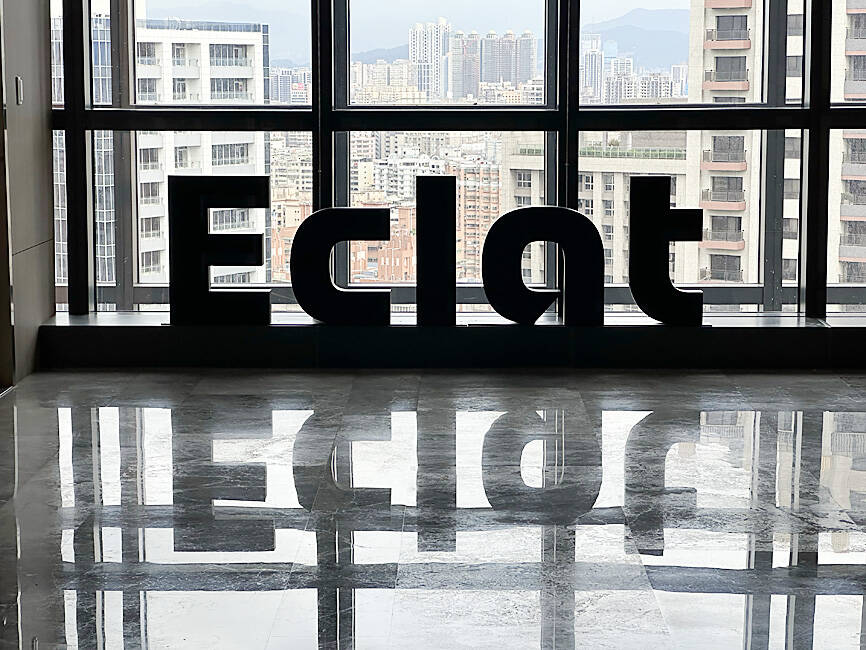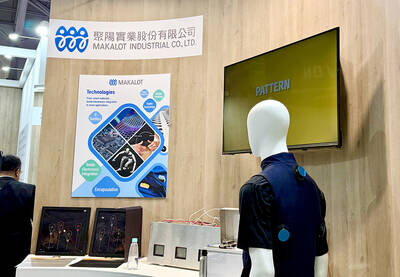Eclat Textile Co (儒鴻) is optimistic about its business outlook this year as it has clear order visibility for the next six months, the garment and fabric supplier said yesterday.
The company said its orders are mostly confirmed for the first half of this year and it has begun to receive new orders for the third quarter.
In addition, the company has seen stronger order growth from mid-sized and high-priced brand clients, it said, adding that the addition of six new customers last year would help contribute about 15 percent to its revenue this year.

Photo: Fang Wei-chieh, Taipei Times
Eclat, which counts global brands such as Nike Inc, Gap Inc, Target Corp, Lululemon Athletica Inc and Under Armour Inc among its top customers, has fabric operations in Taiwan and Vietnam, as well as garment plants in Vietnam, Cambodia, Lesotho, China and Indonesia.
The company said its garment plants have all been running at full capacity, with its outsourced capacity contribution estimated to rise to 30 percent this quarter, from 25 percent last quarter, indicating solid order recovery.
Eclat’s net profit in the fourth quarter last year was NT$1.39 billion (US$44.1 million), up 76.69 percent annually, or earnings per share of NT$5.1.
The increase was buoyed by higher revenue during the October-to-December quarter, which grew 11.3 percent annually to NT$8.49 billion, while gross margin and operating margin improved annually to 32.51 percent and 22.83 percent, respectively, company data showed.
Despite a notable sales recovery and a reversal of declining profit during the final quarter of last year, last year’s overall net profit was still down 23.77 percent annually to NT$5.18 billion and full-year revenue fell 22 percent to NT$30.79 billion due to customers' inventory adjustments.
Earnings per share were NT$18.87 last year, down from NT$24.75 in 2022, but gross margin increased by 3.59 percentage points to 31.44 percent and operating margin rose 1.5 percentage points to 21.28 percent, company data showed.
The increases in margins last year were mainly due to higher factory utilization, better production efficiency, improved product mix and inventories of low-priced raw materials, Eclat vice president for finance and accounting Roger Lo (羅仁傑) said.
Last year, the garment business accounted for 62 percent of the company’s total sales, with the fabric business taking the remaining 38 percent, Eclat vice chairman Richard Wang (王樹文) said.
Looking ahead, Wang said he is not pessimistic about the North American market this year and expects growth momentum to be better than last year, as customers have started to place long-term orders instead of rush orders.
In addition, large brands and channel customers remain active in placing orders, while order momentum from medium-sized brand clients is also quite strong, he said.
The company plans to expand capacity at its Indonesian plants this year and expects new production lines to make a substantial revenue contribution from the second quarter of next year, he added.

Nvidia Corp chief executive officer Jensen Huang (黃仁勳) on Monday introduced the company’s latest supercomputer platform, featuring six new chips made by Taiwan Semiconductor Manufacturing Co (TSMC, 台積電), saying that it is now “in full production.” “If Vera Rubin is going to be in time for this year, it must be in production by now, and so, today I can tell you that Vera Rubin is in full production,” Huang said during his keynote speech at CES in Las Vegas. The rollout of six concurrent chips for Vera Rubin — the company’s next-generation artificial intelligence (AI) computing platform — marks a strategic

REVENUE PERFORMANCE: Cloud and network products, and electronic components saw strong increases, while smart consumer electronics and computing products fell Hon Hai Precision Industry Co (鴻海精密) yesterday posted 26.51 percent quarterly growth in revenue for last quarter to NT$2.6 trillion (US$82.44 billion), the strongest on record for the period and above expectations, but the company forecast a slight revenue dip this quarter due to seasonal factors. On an annual basis, revenue last quarter grew 22.07 percent, the company said. Analysts on average estimated about NT$2.4 trillion increase. Hon Hai, which assembles servers for Nvidia Corp and iPhones for Apple Inc, is expanding its capacity in the US, adding artificial intelligence (AI) server production in Wisconsin and Texas, where it operates established campuses. This

US President Donald Trump on Friday blocked US photonics firm HieFo Corp’s US$3 million acquisition of assets in New Jersey-based aerospace and defense specialist Emcore Corp, citing national security and China-related concerns. In an order released by the White House, Trump said HieFo was “controlled by a citizen of the People’s Republic of China” and that its 2024 acquisition of Emcore’s businesses led the US president to believe that it might “take action that threatens to impair the national security of the United States.” The order did not name the person or detail Trump’s concerns. “The Transaction is hereby prohibited,”

Garment maker Makalot Industrial Co (聚陽) yesterday reported lower-than-expected fourth-quarter revenue of NT$7.93 billion (US$251.44 million), down 9.48 percent from NT$8.76 billion a year earlier. On a quarterly basis, revenue fell 10.83 percent from NT$8.89 billion, company data showed. The figure was also lower than market expectations of NT$8.05 billion, according to data compiled by Yuanta Securities Investment and Consulting Co (元大投顧), which had projected NT$8.22 billion. Makalot’s revenue this quarter would likely increase by a mid-teens percentage as the industry is entering its high season, Yuanta said. Overall, Makalot’s revenue last year totaled NT$34.43 billion, down 3.08 percent from its record NT$35.52